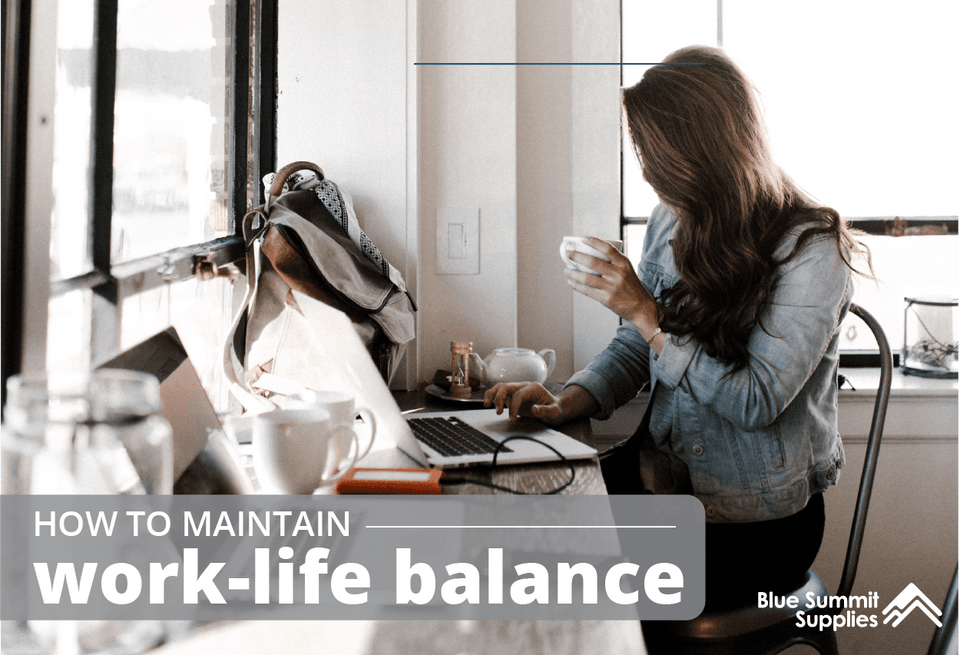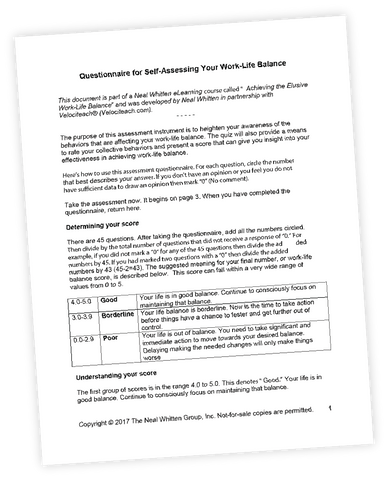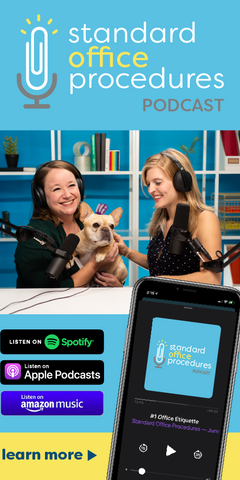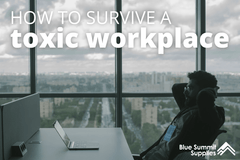Employee burnout is real, and it’s responsible for an estimated $125 billion to $190 billion of U.S. healthcare spending. Without balance, people are unable to lead happy, healthy, and productive lives. Continue reading to learn more about the benefits of work-life balance, including strategies, activities, and how employers can prioritize balance in the workplace.
Work-Life Balance Strategies
Work Smarter, Not Harder
Overworking should never be something you aspire to. Replace your desire to work as much as possible with a balance between work, family, exercise, sleep, leisure, and the activities you enjoy most. Working longer hours does not equate to increased productivity. The stress of working long hours can actually have the opposite effect, leading to poor decision making, workplace mistakes, and anxiety.
Implement a work smarter, not harder mantra to begin using your time more effectively. If you accomplish the same results in the end, does it really matter if you work 35 hours or 60 hours in a week?
💡 Learn The Importance of Time Management and How to Optimize Your Time
Learn How to Say No
Say no. In order to create balance in your life, you need to learn how to say no. This simple strategy can be really difficult for some people. You can’t say yes to everyone and still have time for yourself. Next time someone asks you for a favor or to come to an event, consider if what they are asking will help you reach your own goals. If not, say no.
Of course, you can’t say no to everything, but getting in the habit of saying no sometimes will help you reclaim your time for what matters most.
💡Preventing Burnout in the Workplace: Actionable Strategies for Employees and Employers
Set Specific Priorities
Setting specific priorities and goals for yourself will help you manage your time more effectively. What do you want most? What do you lack in your life? What do you need more of to create balance? If your goal is health-related, you may need to prioritize time for physical activity. How can you find that time in your current schedule, and what might you need to give up?
To add 30 minutes of exercise to your day, you could go to bed earlier so that you have extra time in the morning, add exercise into your daily commute, or find activities that combine physical activity with spending time with family or friends. Whatever you make your priority, stick to it. If someone asks for a favor or invites you to a social gathering, consider how it will affect your top priorities before committing. No one else will make your goals a priority—that’s up to you.
💡How to be More Organized at Work: 10 Strategies to Plan Your Day Right
Work-Life Balance Activities
Meditate
Meditation clears your mind so you can consider the here and now. It’s a good way to decompress after a long day, or to prepare for one, and it only takes a few minutes. Even a short 5-minute mindfulness exercisecan help clear your mind and bring balance to your day. Meditation also improves memory and concentration, which allows us to be present at home when we’re with our families, or at work.
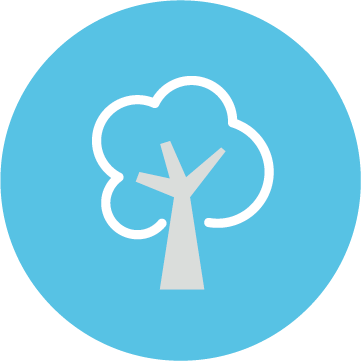
Go Outside
Too often, our work keeps us inside. There are plenty of proven health benefits to being in natureand spending more time outside. Just sitting or walking in a natural landscape resplendent with trees calms our nerves and invigorates our energy. If there are green spaces near your place of work, consider taking your breaks there, or suggest a walking or outdoor meeting. What other activities can you combine with spending more time outside?
Physical Activity
If you’re not someone who regularly exercises, physical activity is an easy suggestion to breeze over. However, we would be remiss not to include it, as exercise boosts our creative and mental energy, improves our sleep, and decreases stress and anxiety. Exercise is restorative. So while a glass of wine after a long day may be preferable, cardiovascular exercise creates new brain cells, renewing our focus in both work and life.
Make Something
Carve out some you-time with a hobby. Is there a hobby from your past you could bring back to life? Or maybe there’s something you’ve always wanted to build or create. Working on creative projects is linked to positive mental wellbeing. Crafting can lead to a stress-reducing state of “flow,”and it releases dopamine in the brain’s reward center as we feel a sense of achievement.
Consider coloring, painting, carpentry, knitting, gardening (this one will get you outside too!), or anything else you’ve always wanted to make yourself. Making cards or gifts can also save you time and money otherwise spent Christmas shopping.
💡Find out How to Find Your Flow and Boost Creative Energy at Work
Learn Something
What's a skill you’ve always wanted to learn? Taking the time to learn something new allows you to focus on yourself for a small amount of time. Personal development isn’t a waste of time as learning something new will ensure you continue to challenge your brain. Who knows, maybe your new skill will come in handy at the office too.
Consider learning a new language, how to play an instrument, how to cook, a sport (this one will get you your exercise at the same time!), or anything else you’ve always wished you knew how to do.
📚 The Importance of Reading Books: 8 Advantages of Reading Regularly
How To Improve Work-Life Balance For Employees
Mandatory Vacation
Vacations are scientifically proven to be good for your health. Create a work environment that embraces balance, one where everyone feels comfortable taking time off work. Mandatory vacation ensures that everyone gets a break and that no one feels pressured to delay a much-needed vacation. Send a clear signal to employees and prospective employees that you value their wellness by ensuring vacation time is utilized.
💡 10 Pros and Cons of Unlimited PTO: Is It Really the Best Vacation Policy?
💡 Preparing for Out of Office (Checklist & Vacation Out of Office Message Template Included)
![]()
Balance Days
Offer employees added opportunities to rejuvenate themselves. Balance days give employees the opportunity they need to prioritize their own wellness. Balance days can be set by the employer throughout the year. For example, you may give your employees a balance day off before a long weekend, or after a big project is completed.
You can also give control of balance days (also known as wellness days or mental health days) to your employees. Give employees a set number of balance days that they can use throughout the year for a personal refresh. An employee doesn’t need to be physically sick to need a pick me up. Plus, enabling employees to spend time on themselves will relieve stress, which will also reduce sick days.
Flexible Hours
Flexibility can mean the world to an employee. Consider offering flexible hours so your employees can manage time based on their own specific needs. Consider a flexible start time of 9 am plus or minus two hours. This gives people the freedom to start their days earlier or later, depending on if they are a morning or night person. It could mean your employees are able to drop their kids off at school or that they have time for a morning workout to kick start their day.
![]()
Remote Work Opportunities
Offering remote opportunities can bring balance to someone’s life in a huge way. Working from home gives employees the freedom to craft their own work environment while helping them to reclaim their time. Commuting to and from work each day eats up a lot of time. The U.S. Census Bureau claims that US workers, on average, spend 26.1 minutes on each one-way commute. For a full-time employee, that’s nearly 5 hours or over 200 hours per year. What could your employees do to bring balance into their lives with that extra time? Even if remote work isn’t an option for your business full-time, consider offering remote work Fridays or the occasional work from home day.
To learn more about the transition from in-office work to remote work, check out this series by ABLE on their team's transition to working from home or check out these articles from our blog.
💡 Benefits of Working Remotely (from Home)
💡 Remote Work Tips and Tools to Temporarily Convert to a Home Office
💡 Working From Home vs. Office: Incorporate Both With a Hybrid Workplace
💡 Remote Team Building Activities: Engaging Remote Employees
Personal Development
Provide personal development opportunities to your team. The chance to learn something new will create balance in their lives while bringing your team together around a non-work-related activity. The learning opportunity doesn’t need to be career-related. In fact, it will be more interesting if it doesn’t have to do with work. Consider a class for cooking, yoga, photography, painting, or crafting.
💡 How to Be the Best Version of Yourself This Year: 11 Resources
Walking Meetings
Walking meetings are a very simple but effective way to bring more balance into your office environment. For small meetings of 1-3 people, encourage employees to take the meeting outside. Walking to a nearby park will get your team outside to reap the health benefits of being in nature, and the extra bit a physical activity will aid both mental and physical health too.
Lead by example as an employer. Set a walking meeting the next time you need to meet with 1 or 2 people. Just make sure everyone is physically up for the walk before finalizing the meeting.
💡 Offsite Retreat Ideas: Meeting Facilitators, City Exploration, Virtual Reality, & More
Learn More About Work-Life Balance
Work-Life Balance Questionnaire
A questionnaire can help you understand where you’re at when it comes to work-life balance.
This Questionnaire for Self-Assessing Your Work-Life Balancecomes from an eLearning course called “Achieving the Elusive Work-Life Balance” developed by Neal Whitten in partnership with Velociteach.
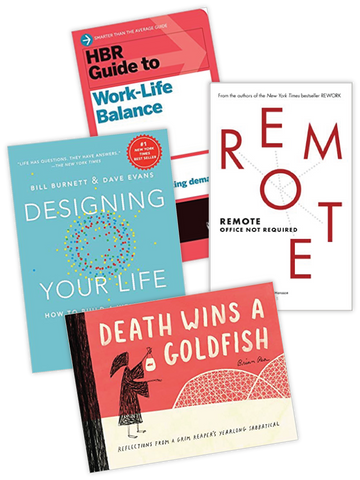
Work-Life Balance Books
The following books can help you create a life that balances work, play, and rejuvenation.
- HBR Guide to Work-Life Balance
- Designing Your Life: How to Build a Well-Lived, Joyful Life
- The Balance Point: Master the Work-Life Balance, Love What You do, and Become an Unstoppable Entrepreneur
- Living Forward: A Proven Plan to Stop Drifting and Get the Life You Want
- Remote: Office Not Required
- Little Book of Mindfulness: 10 minutes a day to less stress, more peace
- Death Wins a Goldfish: Reflections from a Grim Reaper's Yearlong Sabbatical
This article was originally published on October 14, 2019. Updated on January 11, 2023.
More From Blue Summit Supplies
📘 Using a Bullet Journal for Work and Other Agile Organization Resources
🌱The Benefits of Office Plants and How to Take Care of Them
Do you love time management and organization as much as we do? Follow our office supplies blog for the latest trends, strategies, and more.
If you have any questions or want to talk to someone about office supplies, send us an email or connect with us on Twitter, Facebook, or Instagram.
 For more informative articles about office supplies, subscribe to our email newsletter!
For more informative articles about office supplies, subscribe to our email newsletter!
Never fear, you won't begin receiving daily sales emails that belong in a spam folder. Instead, we promise a fun weekly roundup of our latest blog posts and great finds from across the web. And if you lose interest, it's always easy to unsubscribe with a single click.

